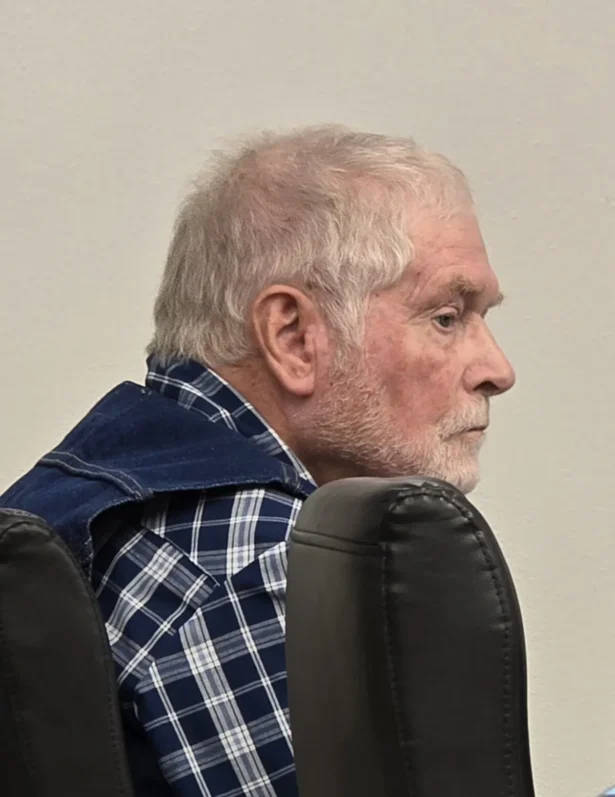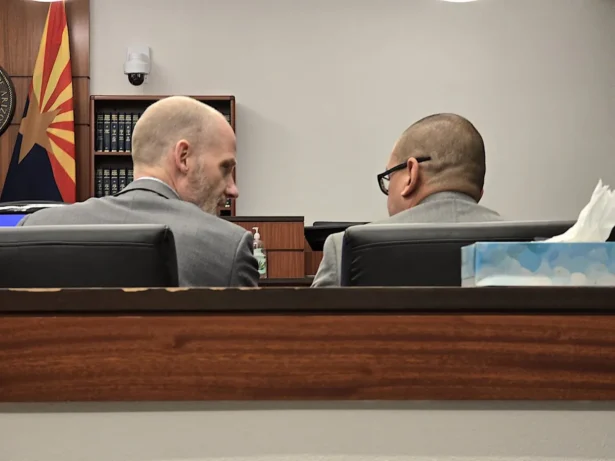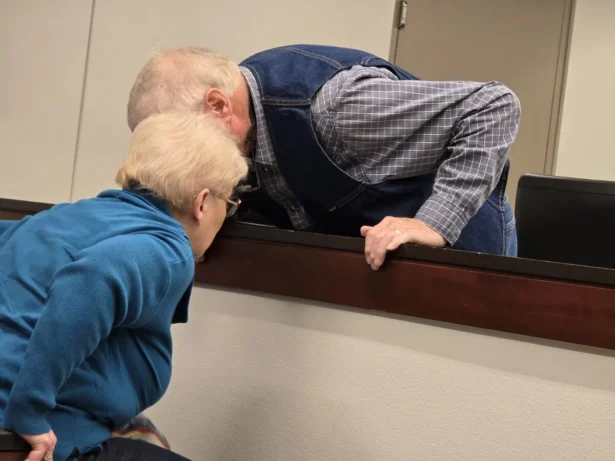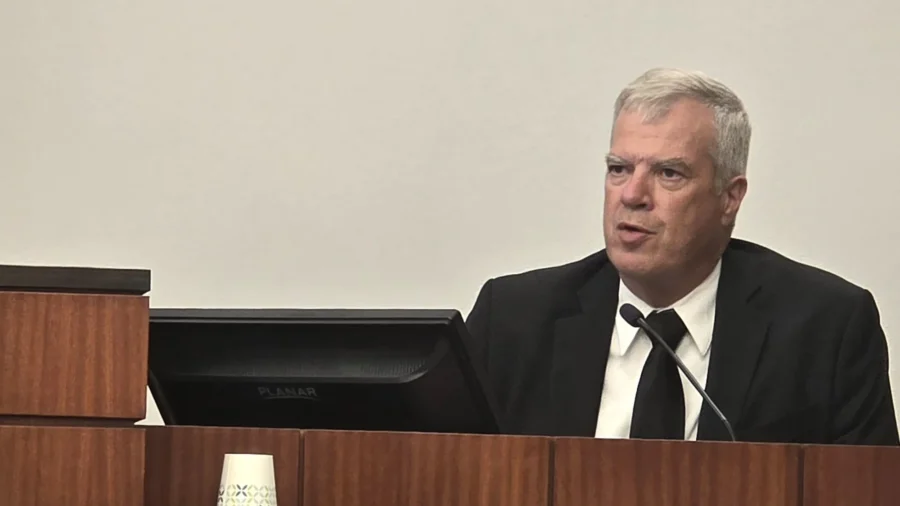NOGALES, Ariz.—Prosecutors in the high-profile murder trial of George Alan Kelly rested their case in an Arizona courtroom as defense lawyers called their first witnesses on April 16.
Court officials said they anticipate final arguments as early as April 17, after which the jury would begin deliberating three weeks of physical evidence and oral testimony.
Mr. Kelly, 75, is accused of firing the bullet from a semi-automatic rifle that struck and killed Gabriel Cuen-Buitimea, 48, an illegal immigrant from Mexico, who was trespassing on his ranch property in the border town of Nogales on Jan. 30, 2023.
Mr. Kelly told authorities that he saw five men, possibly armed and wearing large backpacks, running on his property while he was having lunch.
When he heard a gunshot, he grabbed his AK-47 rifle near the front door and went outside to investigate.
The defendant claimed he then saw men in tactical clothing traveling south and that he fired over their heads when he saw one of them turn and point a rifle at him.
However, sheriff’s deputies and Border Patrol agents said they found no evidence of the men, drugs, weapons, or even a body during an initial sweep of the 170-acre property.
Later that afternoon, Mr. Kelly told investigators he found the deceased victim lying face down on the ground as he went to check on his horse around dinner time.
He immediately placed another call to the Border Patrol ranch liaison to report his finding but was hesitant to talk on the phone.
Investigators later recovered nine spent shell casings near Mr. Kelly’s east-facing porch. Two ballistics experts testified that the victim’s wounds were consistent with a bullet fired from a high-powered rifle but could not say whether the fatal shot came from Mr. Kelly’s weapon.
Crime scene investigators claim Mr. Kelly fired from a distance of 116 yards but have yet to recover a bullet from the alleged crime scene.
Santa Cruz County Sheriff’s Office Detective Jorge Ainza testified that Mr. Kelly was charged with capital murder and placed under arrest based on his making “inconsistent statements” during a videotaped interview.
Prosecutors downgraded the charge to second-degree murder and also charged Mr. Kelly with aggravated assault with a deadly weapon.
On April 16, defense co-counsel Kathy Lowthorp impugned testimony of lead investigator, Mr. Ainza, saying law enforcement intended to portray Mr. Kelly as guilty from the start.

Despite Mr. Kelly’s vigorous denials, investigators continued using the same narrative that he shot at the group of men, not over their heads and away from where he found the body, she said.
“You came into this investigation very focused on wanting to make this about Mr. Kelly being found guilty, isn’t it true?” Ms. Lowthorp asked the detective.
“That is not true, ma’am,” Mr. Ainza responded.
“Well, let’s take a look at how this unfolded, OK? When we talk about alternative [explanations], no piece of evidence supports your theory. Because that’s what it is. It is your theory unless you have supporting evidence,” Ms. Lowthorp said.
Mr. Ainza restated earlier testimony that Mr. Kelly’s “story kept changing” in multiple calls to Border Patrol.
On April 16, defense co-counsel Brenna Larkin questioned a Border Patrol agent and a retired supervisor who testified as to the type and frequency of drug and human smuggling activity that occurs in the vicinity of the Kelly ranch near Kino Springs.
Later, she called on Santa Cruz County Sheriff David Hathaway, a former Drug Enforcement Agency officer, who testified that he does not usually get involved in major investigations that involve his criminal investigations unit.
However, on Feb. 14, 2023, the sheriff said he traveled alone to Mexico to meet with the victim’s two daughters and a man who identified himself as their uncle to express his condolences.
“They were sad. The daughters were crying, and we had a discussion on how to deal with sorrow and grief and to put their faith in God,” Mr. Hathaway testified.
He continued, “In this case, I went down and talked to the family members. They mentioned the witness [Daniel Ramirez]. I had significant experience interviewing people in foreign countries. I speak Spanish, and, um, there was somewhat of hesitancy among county employees, the county attorney’s office, and the sheriff’s office to go to Mexico.”

Mr. Hathaway added, “At this point, I didn’t know if there was really a witness. I didn’t have a name at that date.”
“What is the reason for usually not getting involved in cases?” Ms. Larkin asked the defense witness.
“Well, even though I am peace officer certified as the elected sheriff, I have people that I delegate to do those things,” he said, adding that his detectives were “hesitant” to make the trip.
“Initially, I got involved because I wanted to extend my condolences to the family members. During that meeting, I was told that there was an eyewitness,” Mr. Hathaway testified. “I was already involved at that point.”
“I asked for volunteers. [Detective] Mario Barber volunteered. I told him not to take a gun. Don’t take a uniform. We’re not going to do any enforcement action. We’re just going to talk to somebody if they appear. If somebody, in fact, does appear.”
“Why did you believe you needed to go to Mexico?” Ms. Larkin asked.
“This was a personal witness,” the sheriff responded. “If we really had an eyewitness to this shooting, I haven’t seen anything like this in my briefings in this case … that was the key to this case. I wasn’t going to let that fall through the cracks.”
“Have you heard about a witness by the name of Miguel?” Ms. Larkin then asked.
“I don’t recall,” Mr. Hathaway replied.
“So you don’t recall that in your briefings? Have you heard about a witness named Ramon?” Ms. Larkin asked.

“Yes, I do,” Mr. Hathaway confirmed.
“Did you hear about Ramon prior to hearing about this other witness?” Ms. Larkin asked the witness.
“Yes, prior to,” he replied.
Mr. Hathaway testified that the meeting with the family members of the deceased took place in a hotel restaurant and that he did not document the conversation.
He testified that Santa Cruz County Chief Attorney Kim Hunley later advised him to document the meeting in a report that he filed two months later.
“I was just talking to family members. I didn’t feel the need to document it, and it didn’t seem investigative in nature,” Mr. Hathaway testified.
“That’s why I didn’t write the report. I wasn’t seizing evidence. I wasn’t arresting anybody. This was thrown out that there is an eyewitness out there. My response was I would like to talk to that person.”
“What does that mean?” Ms. Larkin asked.
“I was told that there was an eyewitness that was traveling with Gabriel at the time he was killed,” Mr. Hathaway replied.
“Who told you that?” Ms. Larkin asked.
“Juan Carlos Rodriguez,” Mr. Hathaway answered.

“Why did you ask someone [Mario Barba] to go with you that time?” Ms. Larkin asked.
Mr. Hathaway responded that it was to document the interview if the witness showed up and to create an investigative report.
“It did turn into an investigative act when we were there, and somebody did show up, and they did express they were an eyewitness,” Mr. Hathaway testified. “It was definitely investigative in nature.”
“What caused you to believe you would lose this opportunity if you didn’t take it right then and there?” Ms. Larkin later asked the witness.
“Um, witnesses sometimes disappear. Sometimes, they get killed. You know, he was the victim of an assault. I’ve got to get down what he has to say while he’s here in front of me,” Mr. Hathaway responded.
Detective Barba, however, testified last week that while he kept handwritten notes of the 40-minute interview, Mr. Hathway only documented about six minutes using a tape recorder.
“I want the truth in this. Like in this trial, this forum we’re in right now. I want the truth to come out. I wanted to assess that I was getting the truth,” Mr. Hathaway testified.
From The Epoch Times

